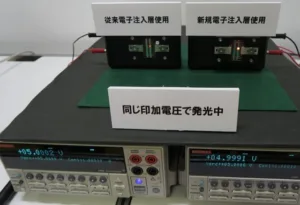In 2013, Japanese broadcaster NHK’s Science & Technology Research Laboratories (STRL) developed a new OLED structure to improve its moisture and oxygen resistance. The development was called ‘inverted OLED’ or iOLED. A full colour version was shown in 2015 and now, more than a year after it was first displayed, NHK has shown it again – still working even though it has almost no encapsulation.
The new (right) and 2015 (left) iOLED devices. Both were driven with a driving voltage of about 5V for comparison of light emission. Image: NikkeiMoisture and oxygen are very damaging to OLED devices, and so they must be sealed. The iOLED does not require such high levels of protection, however. It uses an organic material called polyethyleneimine, rather than the lithium fluoride used in conventional OLEDs.
Despite its resistance advantages, the polyethyleneimine in the 2013 prototype was shown to deteriorate when exposed to a driving current. Its emission lifetime was also low: around 1,000 hours to half brightness, even when sealed by glass. The 2015 prototype featured an improved emission lifetime and a film substrate-based design. The driving voltage had to be higher, however: 5.6V instead of 3.9V, lowering the internal quantum efficiency (IQE) from 100% to 70%.
Alongside the 2015 device, NHK has also shown a new red iOLED using a new organic material and additive for the electron injection layer. These new materials have again lowered the require driving voltage, to 3.7W. The IQE has also been raised to 100%, and emission lifetime increased to 10,000 hours or more.
NHK now plans to develop green and blue iOLED devices with the same properties as the red one.

